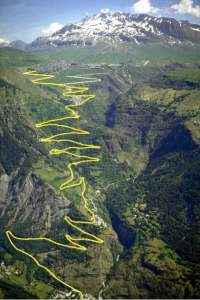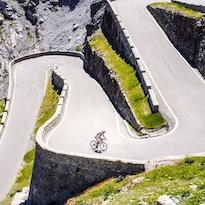For those who enjoy riding outdoors and tackling epic climbs, there’s nothing quite as satisfying as a long ascent broken up by switchbacks. These tight turns divide the challenging climb into manageable segments, making it feel less daunting and more achievable. If you were to compare two climbs of equal distance and grade—one straight and one with numerous switchbacks—the straight climb would feel mentally harder, while the one with switchbacks feels more doable, though not necessarily easier.
This concept translates beautifully into indoor cycling classes. Teaching switchbacks encourages your riders to engage their imagination, helping them visualize the challenge of an outdoor climb—even if they’ve never tackled one on a bike in real life (though they may have driven up a pass with switchbacks!). This approach not only keeps them motivated but also makes the class more dynamic and engaging. It allows you to align the ride with the music, adding an empowering layer to the workout. From a coaching perspective, incorporating switchbacks adds authenticity, reinforcing that what we do indoors mirrors real outdoor cycling, even for those who don’t ride outside.
What is a Switchback?
A switchback, or hairpin turn, is when a road doubles back on itself. In France, these tight turns are known as lacets (pronounced “la-say”), meaning shoelaces—a fitting visual when you look at climbs like Alpe d’Huez or the Lacets de Montvernier (photo below).

Alpe d’Huez, with its 21 numbered lacets, is one of the most iconic multi-switchback climbs in the world.

Another legendary climb is the Passo dello Stelvio in Italy, which boasts an incredible 48 switchbacks! I was fortunate to be able to ride Stelvio in 2017—a bucket list ride—and I can tell you, the switchbacks (along with the stunning views) made the challenge feel slightly less overwhelming. Years of mental strength training from indoor cycling classes certainly helped me reach the summit after 2 hours and 42 minutes of climbing.

It’s not just the Alps that offer this experience—check out Norway’s Trollstigen Pass, known as the “Troll’s Ladder,” another example of dramatic switchbacks.

Switchbacks in Europe vs. the U.S.
Switchbacks are far more common in Europe, where many roads follow ancient foot and cart paths used to access mountaintop villages. Some of these routes even allegedly date back to Hannibal’s journey through the Alps over 2,000 years ago. In contrast, roads in the U.S. tend to be designed with broader, sweeping turns, often using valleys to navigate mountains. The Rockies, where I live and play on my bike, are higher in elevation than the Alps or Dolomites, but they are older and less steep, resulting in the need for fewer switchbacks. While there are a few twisting roads here (Cottonwood Pass, for example), we just don’t seem to encounter hairpin turns as much as in Europe. (On the road, that is…you’ll see in part 2 of this series I give visuals of snaking your way up a twisting single track on a mountain bike!)
Teaching Switchbacks Indoors
When I first introduced switchbacks to indoor cycling in my 2002 “Rolling Hills and Switchbacks” workshop, I described them as irregular “jumps on a hill,” alternating between seated and standing climbs. But not all switchbacks are created equal! Over the years, I’ve developed more varied and nuanced ways to simulate switchbacks, keeping the experience fresh and realistic.
This isn’t your typical “Obsessed with Cycling Drills” post. I’m diving deep into the concept of switchbacks to help you bring the outdoor experience indoors with plenty of creative ideas. Personally, I don’t refer to switchbacks as drills—they’re just one of the many ways I coach uphill simulations to keep things interesting. However, I understand that many instructors do call them drills, and that’s OK if it resonates with your coaching style.
In this two-part series, I’ll provide general advice on teaching switchbacks and how to use music to enhance the experience. In part 2, I’ll outline five distinct scenarios for teaching switchbacks on a stationary bike, allowing you to integrate them into any climbing profile.
General Tips for Teaching Switchbacks:


Thanks, Shari!
Wait until the Rolling Hills one comes out! =)
I think this series is an ICA gem. I am learning a ton and cannot wait to coach my climbs with more variety!